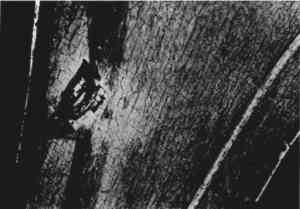THE CONSERVATION OF A PAINTED BALTIMORE SIDECHAIR (ca. 1815) ATTRIBUTED TO JOHN AND HUGH FINLAYPETER L. FODERA, KENNETH N. NEEDLEMAN, & JOHN L. VITAGLIANO
3 ANALYSISTwo samples were taken for cross-sectional analysis, one from the underside of the proper right rear leg (sample 1) and one from the swag on the proper right front leg (sample 2). The samples were embedded in epoxy, polished, and examined for stratigraphy using light microscopy and scanning electron microscopy (SEM). SEM with energy dispersive x-ray fluorescence spectrometry (SEM-EDS) was used to determine the elemental composition of each layer for the purpose of pigment identification (Wypyski 1994). The embedded samples were also sectioned by microtome, and the Directly on top of the wood is a blue paint layer (see fig. 12) containing lead white (major component) and Prussian blue (minor component) (Wypyski 1994). This thin, uniform layer could be seen throughout the chair, suggesting that it may have functioned as a primer. Above it is a white paint layer containing lead white (major component) and calcium carbonate (minor component). Above this is a yellow-brown coating, another layer of lead white and calcium carbonate, a glaze layer containing white lead and calcium carbonate, and a yellow paint layer containing chrome yellow (lead chromate). Directly on top of the yellow paint is a fluorescent layer we believe to be an original resin coating. Above it is another fluorescent coating displaying a dark upper surface, followed by a series of four fluorescent coatings.
Sample 2, taken from a swag on the proper right front leg, exhibited similar stratigraphy as far as the preparatory layers, the yellow, and the surface coatings are concerned. A black layer on the top of the yellow, corresponding to details from the swag, contained a mixture of black, blue, red, and brown pigments (Martin 1995). Iron, silicon, aluminum, lead, calcium, potassium, manganese, and titanium were detected with SEM-EDS, with iron being the major component. A light blue highlight was determined, with SEM-EDS, to consist of lead white (major component) and Prussian blue (minor component) (Wypyski 1994).4 Two pigment samples were taken from the crest rail—one from the red details on the scrolled acanthus and the other from the background of the frieze. These were analyzed using PLM and Fourier transform infrared microspectroscopy (FTIR). The red paint sample contains iron earth pigments, associated mineral impurities such as calcium carbonate, and trace Prussian blue. The background area of the frieze is a mixture of Prussian blue and an unidentified pale yellow pigment, possibly litharge. Both pigment samples contained particles of surface varnish, which impeded characterization of the binding media (Martin 1995). The identification of chrome yellow is an interesting finding that demands further consideration and discussion, as chrome yellow appears to have first come into use in Europe around 1810. Beginning about 1808, chromite mines in the Pennsylvania-Maryland region became internationally important, and it has been suggested that they played a key role in the production of chrome pigments in England sometime between 1814 and 1816 (Kuhn and Curran 1986). The Kaufman chair is generally considered to have been made around 1815, so it is tempting to say that this date fits very neatly. In light of the proximity of the chromite mines and the earlier occurrence of the yellow in Europe, the questions of when and how the Finlays learned of chrome yellow and when they began using it invite further exploration.5 |
